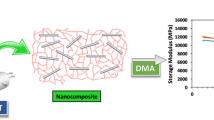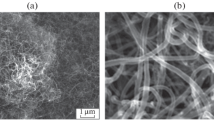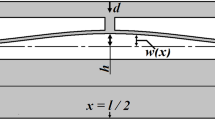Abstract
In this research, we present the preliminary results related to our investigations on the potential of electrical signals through the network of nanoscale reinforcements and the consequent Joule heating in polymer-based nanocomposites as a means to augment damping in the material. The intended damping mechanism in this case is the creep and relaxation in the matrix phase, which is to be intensified via locally increased temperatures. The reinforcement of choice will be carbon nanotubes. The effectiveness of this method partly depends on rate and special uniformity at which the temperature of the matrix is increased, and as such it scales with the surface to volume ratio of the reinforcements. To demonstrate active damping augmentation experimentally, composites were then fabricated with the carbon nanotubes (CNTs) randomly distributed within an epoxy matrix. The active control of the damping behavior was pursued by joule heating the CNT reinforcements during the dynamic tensile testing on a Dynamic Mechanical Analyzer (DMA). Damping was quantified by the ratio of loss to storage modulus, equivalent to the ratio of dissipated mechanical energy to the elastic energy stored in the material during dynamic loading.
Access provided by Autonomous University of Puebla. Download conference paper PDF
Similar content being viewed by others
Keywords
29.1 Introduction
Energy dissipation during oscillatory loads, also known as vibration damping, is an important function of structural components not only to enhance performance but also for reliability in the structural response. Traditionally, approaches to suppressing structural vibration consist of externally attached dampers in addition to any inherent damping capability in the structure, which can lead to issues of increased weight and physical space. The advancement of materials for damping is relying not only on achieving advanced structural performance but also on developing materials with multifunctional capabilities. An effective alternative to traditional approaches is to provide a means for the damping mechanism within the structural material itself, which could then be triggered by external means. Specifically, polymer composite structures are of interest. The focus on polymers comes from their low density, ease of manufacturability, and large range of applications [1–3]. In addition, polymers show significant enhancement in damping capability near the glass transition temperature [4]. One approach to enhancing the energy dissipation in polymers, while increasing effective stiffness, is by embedding these polymers with nanoparticles. This approach would be attractive to many applications due not only to the minimal increase in weight and lack of external components, but also the additional improvement in mechanical properties, such as elastic modulus, yield strength, electrical conductivity etc. For example, one can take advantage of the electrically conductive path formed by these fillers, and thus pursue an active damping technique. In this regard, Joule heating of these fillers can result in local heating of the matrix, to near the glass transition temperature where polymer damping is most effective, thus allowing for the viscoelastic properties of the matrix to additionally contribute to damping. The high surface to volume ratio of the nanoscale reinforcements will accelerate the damping mutation of the matrix by facilitating the heat transfer. However, interfacial thermal resistance must be taken into account as to not damage the composite with prolonged electrical signals.
Active damping consists of modulating the damping properties of a structure or structural material via external stimuli, mainly but not limited to electrical signals. Since the viscoelastic properties of the matrix, which is highly temperature-sensitive especially near glass transition temperature, can add to the energy dissipation of a structure, one approach to augment damping in polymer-based structures is by temperature control of the polymer via an external stimulus. Active heating of the polymer to exploit the thermomechanical coupling inherent to polymers has been shown to have potential in damping applications. Smith et al. developed a tuned-mass damper that could be continuously varied, and thus self-tune, by taking advantage of the temperature-sensitive viscoelastic properties of the polymer [5]. The polymer relaxation mechanism has also been shown to be effective in improving the impact response of carbon fiber polymer matrix composites [6]. Similar techniques have also been used to actively control the damping capabilities of carbon microfiber reinforced composites leading to reduced deflection and stresses in the composite [7]. Even though these results show that this mechanism is effective in improving the damping capabilities of microfiber composites, a more efficient activation of this mechanism is expected with the addition of nanoscale reinforcements. This is because the high surface to volume ratio of the fillers will facilitate the transfer of heat from the particle to the matrix.
The goal of the present research is to test the hypothesis that damping of a polymer based nanocomposite can be actively and controllably augmented via electrical signals. The potential of using joule heating of embedded nanoparticles in modulating the damping capabilities of nanocomposites is investigated. The intended damping mechanism is the relaxation of the matrix surrounding the nanoparticle. The relaxation of the polymer is enhanced by the local increase in temperature. The main parameter to control during this study is the magnitude and duration of the input heat flux to be controlled via electric signals.
29.2 Experimental
29.2.1 Processing
The epoxy resin, EPON™ 862, and curing agent, EPIKURE™ W, used in this study were both obtained from Hexion Specialty Chemicals, Inc. The CNTs, which contain mostly single-walled CNTs were purchased from Carbon Nanotechnologies, Inc. (Unidym, Incorporated) and were used as is with no surface functionalization. The composite fabrication was taken from [8], described as follows. Carbon nanotubes were first ground in 2 ml of ethanol with a mortar and pestle. The CNT bundles were then dispersed, in a flask, in a mixture of toluene and ethanol with an ultrasonicator bath for 1 h. The nanotube/solvent solution was added to the EPON™ 862 resin and magnetically stirred at 400 rpm and 60 °C under vacuum until all the solvent evaporated. The epoxy was pre-cured with 20 % of the total amount of the curing agent (100:26.4 by weight), at 120 °C for 200 min, after solvent evaporation. The solution was then cooled to increase its viscosity and the remaining amount of curing agent added. The CNT/epoxy solution was then poured into a mold with a curing cycle set to 8 h at 40 °C followed by 2 h at 120 °C and another 2 h at 175 °C. Composites with 1 wt% CNT concentration were fabricated.
29.2.2 Mechanical Characterization
Dynamic mechanical analysis (DMA) was performed using a TA Instruments RSAIII DMA. In order to obtain the dynamic response as a function of temperature on the neat polymer, a temperature sweep was performed by varying the chamber temperature from 25 °C to 180 °C at a rate of 10 °C/min. The dynamic strain amplitude was fixed at 0.1 % and the frequency at 1 Hz. The CNT/epoxy composite was tested at a fixed dynamic strain amplitude of 0.1 % and a frequency of 1 Hz. To investigate active damping, the temperature of the sample was varied via Joule heating of the composite using a voltage amplifier and a function generator. The voltage was applied via a two point probe formed by copper wires which were glued to the sample using high purity silver paint, thus minimizing any Joule heating at the electrodes. The testing set-up is shown in Fig. 29.1. The voltage was varied from 0 to 60 V as a means to control the heat flux and the temperature of the sample. The change in storage modulus and tan δ was recorded as a function of time. Thermal images were obtained using an infrared camera and the surface temperature of the sample was monitored during testing.The ratio of loss to storage modulus, tan δ, was reported as a measure of energy dissipation capability of the material.
29.3 Results and Discussion
The DMA response of epoxy as a function of temperature during the temperature sweep experiment (no Joule heating) is shown in Fig. 29.2. As observed in the plot, the maximum dissipation, tan δ, occurs around the glass transition temperature of the material, ~140 °C. The tan δ increases by up to a factor of 47, however this increase in damping comes at a cost of a significant decrease in storage modulus. Therefore, in order to maintain a considerable portion of the composite stiffness, joule heating was performed to temperatures just below the Tg of the epoxy.
The active damping performance of the composite via joule heating are shown in Figs. 29.3 and 29.4. The results show that as the voltage potential is applied to the sample, the damping capability of the structure increases while the storage modulus shows a sudden drop which correlates with an increase in tan δ. For instance, an applied voltage of ~60 V nearly doubles the tan δ, while the storage modulus is reduced by 40 %. This result points to polymer relaxation as the thermally activated mechanism to enhance the damping behavior of the composite material. In addition, the sudden change in storage modulus is an indication of effectiveness of the CNTs as volumetric heat sources, with the CNTs providing rapid heating of the sample. This rapid heating will allow for controllability of the active damping of the material.
By taking advantage of the polymer relaxation resulted from an increase in temperature, the composite shows the potential for damping enhancement. However, this enhancement in damping comes at a significant cost in decrease of storage modulus. While the loss of modulus may adversely affect the structural performance in some applications, it has been shown that a reduction in stiffness of structural components in civil structures has led to a decrease in absolute accelerations and related forces [9]. In addition, vibration suppression has been pursued by using variable-stiffness members [10]. However, in order to minimize or control the decrease in modulus, an alternative approach is to use semi-crystalline polymers instead of an amorphous polymer. With a semi-crystalline polymer, the storage modulus will decrease by a less relative amount at the glass transition temperature. That is because the crystalline structure will remain intact at Tg, since this temperature is below the crystal melt temperature. Therefore, the crystalline structure in the material will maintain some storage modulus while still allowing the polymer chains within the amorphous regions to have some relative movement, which will contribute to the energy dissipation in the material.
29.4 Conclusions
The active damping potential of CNT fillers in polymer matrix composites was investigated through experimental techniques. The thermomechanical response of the polymer was targeted and studied as a potential damping source within the nanocomposite. The nanoscale reinforcements were used as heat sources, via joule heating, to trigger the matrix relaxation. By taking advantage of the polymer relaxation resulted from an increase in temperature, the composite shows the potential for damping enhancement. The high surface to volume ratio of CNTs facilitated the heat flow from CNTs to matrix, resulting in rapid damping augmentation. Future research should be focused on semi-crystalline polymers, to minimize the undesired loss of storage modulus which accompanies the increase in damping capability.
References
Gangopadhyay, R., De, A.: Conducting polymer nanocomposites: a brief overview. Chem. Mater. 12(3), 608–622 (2000)
Harris, P.: Carbon nanotube composites. Int. Mater. Rev. 49(1), 31–43 (2004)
Schmitt, C., Lebienvenu, M.: Electrostatic painting of conductive composite materials. J. Mater. Process. Technol. 134(3), 303–309 (2003)
Gong, Z., et al.: Investigation of the effects of temperature and strain on the damping properties of polycarbonate/multiwalled carbon nanotube composites. J. Phys. Chem. C 115(38), 18468–18472 (2011)
Smith, K.E., Maly, J.R., Johnson, C.D.: Smart tuned mass dampers. In: Active Materials and Adaptive Structures: Proceedings of the ADPA/AIAA/ASME/SPIE Conference (1991)
Sierakowski, R.L., Telitchev, I.Y., Zhupanska, O.I.: On the impact response of electrified carbon fiber polymer matrix composites: effects of electric current intensity and duration. Compos. Sci. Technol. 68(3), 639–649 (2008)
Barakati, A., Zhupanska, O.: Thermal and mechanical response of a carbon fiber reinforced composite to a transverse impact and in-plane pulsed electromagnetic loads. J. Eng. Mater. Technol. 134(3), 031004 (2012)
Gardea, F., Lagoudas, D.C.: Characterization of electrical and thermal properties of carbon nanotube/epoxy composites. Compos. Part B 56, 611–620 (2014)
Cimellaro, G.P.: Simultaneous stiffness–damping optimization of structures with respect to acceleration, displacement and base shear. Eng. Struct. 29(11), 2853–2870 (2007)
Onoda, J., et al.: Vibration suppression by variable-stiffness members. AIAA J. 29(6), 977–983 (1991)
Author information
Authors and Affiliations
Corresponding author
Editor information
Editors and Affiliations
Rights and permissions
Copyright information
© 2016 The Society for Experimental Mechanics, Inc.
About this paper
Cite this paper
Gardea, F., Lagoudas, D., Naraghi, M. (2016). Active Damping in Polymer-Based Nanocomposites. In: Ralph, C., Silberstein, M., Thakre, P., Singh, R. (eds) Mechanics of Composite and Multi-functional Materials, Volume 7. Conference Proceedings of the Society for Experimental Mechanics Series. Springer, Cham. https://doi.org/10.1007/978-3-319-21762-8_29
Download citation
DOI: https://doi.org/10.1007/978-3-319-21762-8_29
Publisher Name: Springer, Cham
Print ISBN: 978-3-319-21761-1
Online ISBN: 978-3-319-21762-8
eBook Packages: EngineeringEngineering (R0)








